Please use the following link to download the August 17, 2019 issue of the syəcəb:
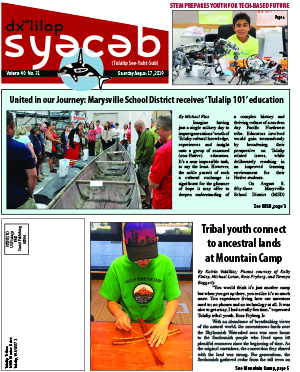
syəcəb
Please use the following link to download the August 17, 2019 issue of the syəcəb:



By Kalvin Valdillez, Tulalip News
You couldn’t have asked for better weather on the evening of August 6. With clear skies, a light breeze and a beautiful view of the bay, Tulalip community members gathered at the parking lot of the Don Hatch Youth Center to celebrate the 36th annual National Night Out with local tribal law enforcement officers. A fun occasion for all generations, the citizens shared good times with the Tulalip Police Department (TPD) at the yearly summertime event by getting to know the officers on a personal level and thanking them for protecting our tribal society.
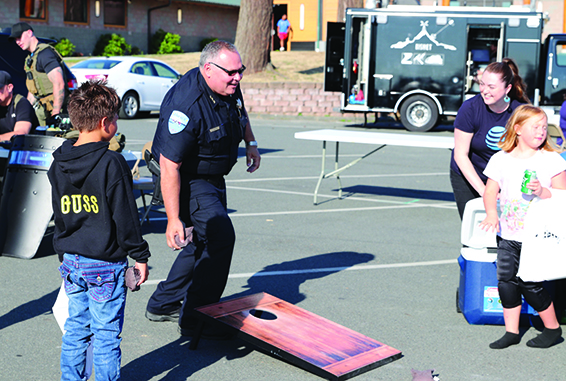
“National Night Out is a wonderful opportunity to mingle with the community and let neighbors reconnect with each other, and also with the police in a non-enforcement way, in a social setting,” stated Tulalip Chief of Police, Chris Sutter. “Hopefully after tonight we’ll know each other a little better, form new friendships and also reinforce our relationship with the Tulalip community. The police department coordinated this and we invited other tribal departments and other first responders. It’s my hope to do this event every year, but also find new ways to connect and get out and meet with Tulalip’s individual neighborhoods, get to know their issues and also further develop trust and strengthen those relationships.”

Two officers were assigned to grilling duties as the smell of barbequed hot dogs and burgers filled the air. After enjoying a meal with the coppers, National Night Out participants checked out all of the booths at the event, learning about services offered at programs such as the Tulalip Child Advocacy Center, the Betty J. Taylor Early Learning Academy and Behavioral Health. The Tulalip Office of Emergency Management provided safety information and the Tulalip Lions Club graciously donated numerous books to the youth.
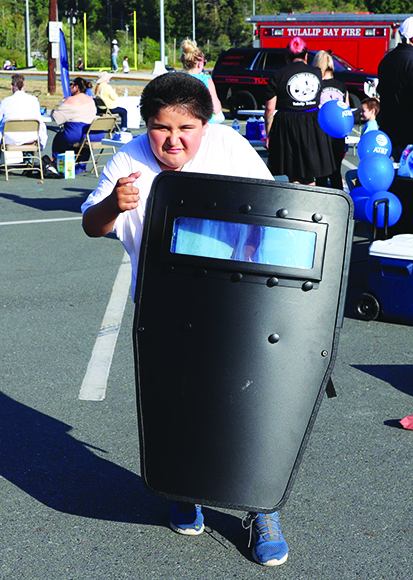
The Tulalip Bay Fire Department brought one of their shiny red fire engines to National Night Out so the youth could get a firsthand, up-close look at the emergency vehicle. For years the tribal fire department and police department have had a friendly feud but during emergency situations, as well as at events like National Night Out, the first responders put aside their differences to show support to their uniformed rivals.
“This is one of those great community events that happens all over the country,” said Tulalip Bay Fire Department Deputy Chief, Jim Reinhardt. “The Tulalip Bay Fire Department feels a real sense of ownership with this community and we really try to show our support for these types of events. The solidarity that we have with the police department, we’re both on the same team for different reasons, but TPD is always supporting our efforts and we’re always out there for them and we’re both here together for the people.”
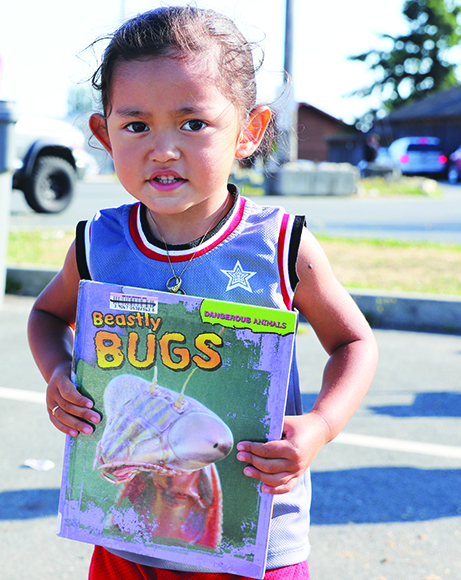
The kids of the community had a blast at National Night Out, looking up to their local heroes, jumping about the bouncy houses, touring the Tribe’s Search and Rescue boat and playing fetch with Tulalip K-9 Officer, Cait. The youth also went home with a variety of gift bags filled with police badge stickers, toys, coloring books and fun stationary supplies.
“It feels nice to participate with the community,” expressed Tulalip Youth Skylar Yellowwolf. “You get a behind-the-scenes look at the people who help us. There’s a lot of incidents and a lot fires that happen on the rez and here at National Night Out, you can see the faces of those people who keep us safe and protect us, and also see how they help and what they do. It’s nice because I feel like with the cops, there could be a lot of negative perspectives. So, to teach kids at a young age that the cops are here to help you —it provides them with a really good and safe environment to grow up in.”

The highlight of the night this year, for adults and children alike, was the opportunity to try on and test out tactical gear, which TPD officers use during hostile missions. Throughout the two-hour event, TPD officials helped community members slip into bulletproof vests and explained the use of their various tools.

“This is our emergency response gear which is basically another way of saying SWAT gear,” explained TPD Officer Ian Schmitz. “We brought out some of the tools and equipment we use; vests, shields, rams and other toys. These are basically the stuff we use for our missions, it’s not our everyday gear we wear when we’re on patrol. Kids love checking out our gear, it’s always great to see the young ones come up with big bright smiles on their faces, that’s the best part about doing this, the kids. National Night Out is basically a bonding experience between the community and TPD. The event opens up people’s eyes and minds to what goes on around here. And it’s in our community, which is nice, it’s great just seeing all of these people on a good note. It’s nice being out here, interacting with the community, smiling, laughing and building that trust and comradery between the people and our department.”
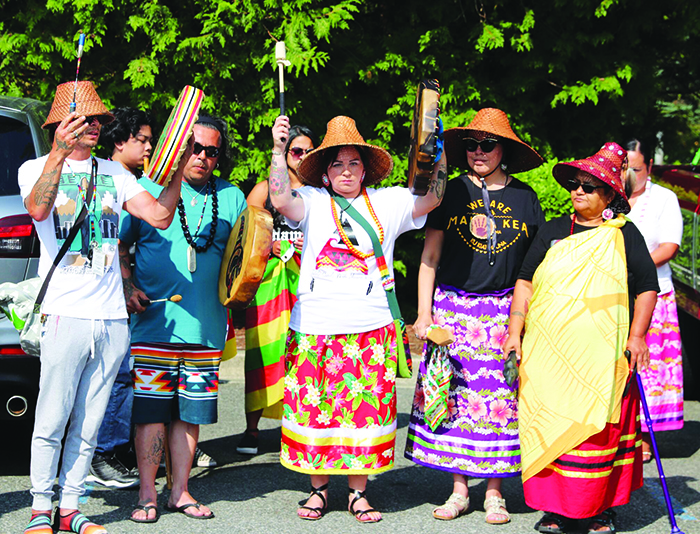
By Kalvin Valdillez, Tulalip News
Miles away in Hawaii, thousands of Native Hawaiians created a barricade blocking the only road leading to the top of Mauna Kea. The elders, or kūpuna, are bravely positioned at the frontlines, peacefully preventing the construction of an 18-story, thirty-meter telescope (TMT). The stand is now in its third week and Hawaiian activists, and many supporters, continue to hold their ground, protecting the highest peak in Hawaii, the sacred mountain Mauna Kea.
“We are protectors, not protesters,” exclaimed Native Hawaiian and Director of Equity for the Mukilteo School District, Gerry Ebalaroza-Tunnell. “Protesting has such a negative connotation, we want to set the space and let people know that we are coming to this place based off kapu aloha, because we just want to bring awareness to what’s going on.”
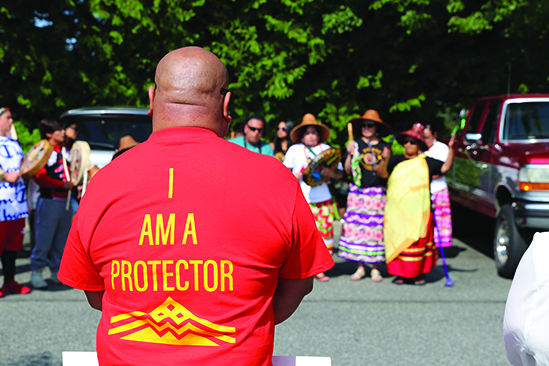
Over one hundred Tulalip community members and local Hawaiian families met at the Marysville Haggen parking lot on the morning of August 3. Several Saturday shoppers made their way to the backend of the lot to see what was going on, just in time to witness a cultural exchange as the Tulalips and Hawaiians offered songs and words, each in their respective languages. The crowd received a handout with lyrics of Hawaiian songs as well as ‘ōlena, also known as turmeric, both in powder and plant form. The Hawaiian community then performed a ceremony for protection complete with hula dancing and pahu drumming.
“The reason we do protocol together beforehand is because when the dominant culture sees a bunch of brown people together, they see us as protestors, as trouble,” explained Gerry. “So, we came together this morning for protocol to pray and sing and call upon our ancestors from all directions to protect us while we’re out bringing awareness. It was amazing to see the elders coming together and acknowledging each other, the land we’re on and why we are here.”
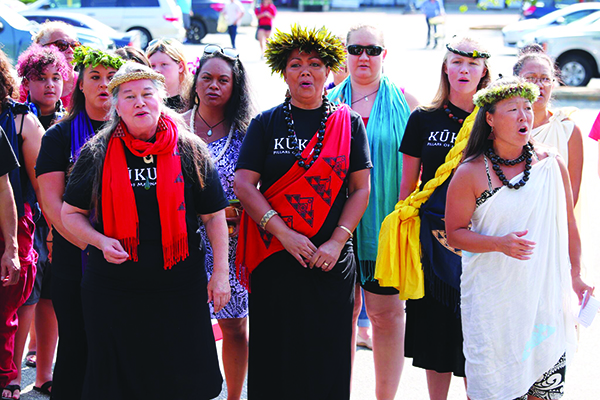
The fight to defend Mauna Kea has recently gained national news coverage as Hollywood actors Dwayne “The Rock” Johnson and Jason Momoa, as well as reggae musician Damian Marley, visited the kiaʻi (protectors) of Mauna Kei. Although the news may be new to some, the Native Hawaiians have been actively opposing this particular project for nearly a decade. The kia’i celebrated a victory in 2015 when the Hawaiian Supreme Court repealed the permit for the construction of the TMT. Last October, however, the Supreme Court of Hawaii delivered a new ruling which allowed Hawaii’s Board of Land and Natural Resources to issue another permit to the TMT group.
Hawaiian Governor David Ige announced this past July 10, that construction of the telescope would commence on July 15. The kia’i immediately sprung to action and assembled on Mauna Kea. After halting the construction for three straight days, the Governor issued an emergency proclamation which granted law enforcement more authority to begin making arrests. Heartbreaking footage shows the first arrests of the kūpuna, the Hawaiian knowledge keepers who volunteered to be at the frontlines, take place.
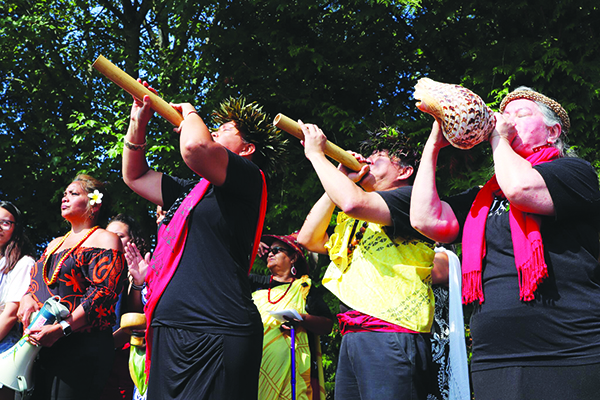
Elders who needed the assistance of wheelchairs or walkers had to be escorted to the squad cars by their own family members and those kūpuna who refused to leave were cuffed and carried out by multiple officers. The tears of the elders pulled at the heartstrings of those watching and hundreds of supporters begin to arrive daily to protect the sacred mountain.
If you measure the one-million-year-old dormant volcano from its underwater base, the sacred Hawaiian mountain is over 33,000 feet in total, making it the tallest mountain in the entire world. Because of its high elevation, the mountain has attracted a number of astronomy research groups. In fact, several observatories have already been established on the mountain since Hawaii became a state in 1959.
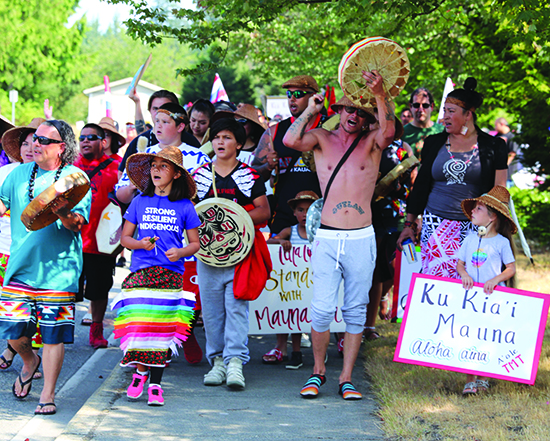
According to numerous reports, the land where Mauna Kea is located, was originally stolen from the people and then later obtained by the United States government. Through the Statehood Act, the state of Hawaii received the rights to the land which has since been managed by its current lease holder, the University of Hawaii. The university pays the state of Hawaii one dollar a year and in turn subleases the land to each observatory for a dollar. The TMT in particular is a $1.4 billion project designed and developed by the TMT International Observatory LLC (TIO).
“Being an Indigenous scholar in western academia and seeing them trying to build the TMT in the name of science, I don’t see the science they’re talking about,” Gerry expressed. “The science I look at, and I think many people here do as well, is the connection that we have to the land. What we’re doing today is gathering together, because there’s strength in numbers, to bring awareness to the desecration of our sacred lands. The more awareness we raise, we’re hoping it will put more pressure on those who are wanting to desecrate our lands and get a seat at the table to be a part of the decision and the discussion, because for too long they’ve tried to silence our voices.”
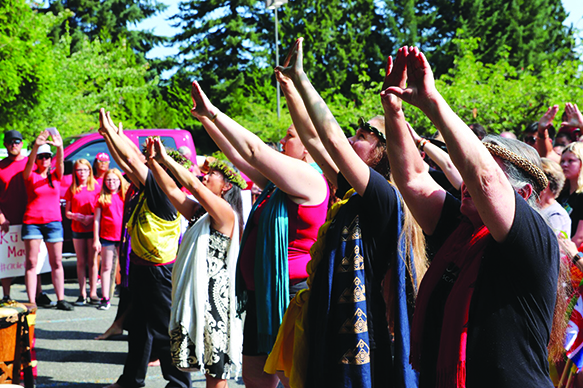
With dual-sided flags waving high, one side an upsidedown Hawaiian state flag and the other the Kanaka Maoli flag, the large crowd made their way from the Haggen parking lot to the I-5 overpass between exits 199 (southbound) and 200 (northbound). As the local protectors marched, they held up signs reading, We Are Mauna Kea, Defend the Sacred and Tulalip Stands with Mauna Kea.
The fight sounds all too familiar to the Indigenous peoples of America who share many experiences of the U.S. government exploiting Mother Earth for profit and colonization. But perhaps the reason the Mauna Kea movement resonates and has an amazing amount of support from Native Americans is because the mountain top is sacred to its local populous. That should be reason enough for construction to stop indefinitely but unfortunately the Hawaiians are now being asked to define what sacred means to them exactly.

TMT developers wish to build the telescope on the northern plateau of Mauna Kea, an area described by the kai’i as untouched, pristine land in which many villagers and residents of surrounding islands visit solely for the purpose of spiritual work, where they perform rituals for healing and have conversations with the higher power. The plateau also overlooks the river that provides the water for the majority of the island. The protectors have concerns that the giant telescope would negatively affect their water supply and local marine habitat. Most importantly, the mountain is a living spirit that has been a major part of Hawaiian history since the beginning of time.
“I’m originally from Hawaii, my family is from Hawaii,” stated Mauna Kea Rally Organizer and Tulalip community member, Absyde Kaiulani Dacoscos. “Since I can’t be there physically, I was trying to figure out how I can show my support and I started going to nearby rallies in Seattle. Something called to me, I knew in my heart I needed to do something here to show support. With the help of my cousin Gerry, Natosha (Gobin) and Sara (Hart), we put this together. This is not just about the Mauna, it began as that, but it’s so much more. It’s about all Indigenous people and how our lands are being stripped away from us. It’s not right, it’s sacred, it’s ours. We need to keep what’s left for our future generations. I work for the Tribe, I’m a teacher’s assistant at TELA, and I love the culture. I just wanted to bring all of our Indigenous brothers and sisters together because we understand each other’s fight.”
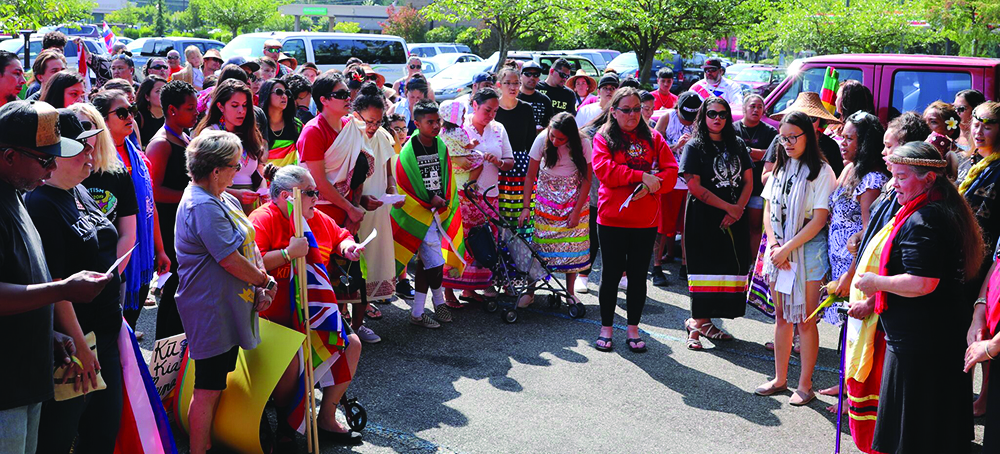
For over four hours, the two Indigenous communities banned together to raise awareness, receiving plenty of support from both local commuters and I-5 traffic. Throughout the afternoon the protectors received empathic honks, cries of support and some passengers even threw up the shaka sign out their windows to show solidarity. Among the many protectors was the Tulalip Youth Council who dedicated their entire Saturday to the movement.
“The Youth Council all felt it was important to be here,” said Council Member Marisa Joseph. “I like seeing everyone united for one cause. Having the youth here shows a strong message and shows that we can come together as one. It shows our love and how strong we are together.”

On the other side of the freeway, in the vacant lot across from the Bank of America, a canopy was set up for the protectors to get a little shade from the hot sun as well as to replenish with ice cold water and enjoy Hawaiian delectables, such as musubi, catered by Bobby’s Hawaiian Style Restaurant. A group of Tulalip drummers also brought awareness to drivers hopping onto the freeway or crossing the overpass, by holding up signs and singing traditional Tulalip songs. Tulalip tribal member and Mauna Kea Rally Organizer, Sara Hart, proudly sang while draped in her Coast Salish garb. Sara recently returned to the Pacific Northwest after traveling to Mauna Kea to stand with the people of Hawaii.
“For me, this is a huge movement,” stated Sara. “Indigenous people uniting together is beautiful. We need to stand together and fight for our sacred lands and waters; together we’re stronger. When I went over there it was the most unity I’ve ever felt, the most love I ever felt. Being there every day for protocol, singing with them and feeling that love and unity was amazing and to see that happen here today was very moving and beautiful. I think it’s important to learn their protocol and also bring ours to the table, so we’re accepting of one another and we’re opening up the floor in a good way.

“I would like the protectors of Mauna Kea to know that we here in Tulalip and our surrounding communities are continuously sending love and prayers every day for them to protect the mountain and to protect themselves. That is their church, that is their holy place and that telescope doesn’t belong there.”
Due to the amount of growing support, the Hawaii Island City Council recently passed a sixty-day construction moratorium. In response, Governor Ige canceled the emergency proclamation but granted a two-year extension for the start of the TMT construction. Though the fight is far from finished, the kia’i have successfully prolonged the construction of the telescope for the time being. A small victory that speaks volumes.
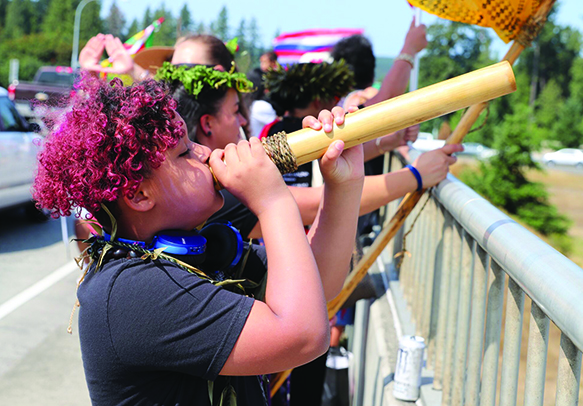
“It tells me that people see us, that we’re not invisible,” Gerry tearfully expressed. “For far too long we’ve been made invisible; our voices have been shut down. We’re seen as others, we’re seen as people who cause trouble, that we should just shut up and let people do what they want with our lands. What’s happening over at Mauna Kea has been going on for quite a while now. About three weeks ago, when our kūpuna were being arrested, we saw what was really happening on the islands and we knew we had a call we needed to make to our fellow Indigenous people. I honestly didn’t know how many people would show up today, I was not expecting this many. Seeing Native Americans and Native Hawaiians, people of the land, come together to rise up and stand in solidarity — my heat’s full. It makes me feel happy, joyful, and most of all, hopeful.”
If you would like to support the kai’i of Mauna Kea with monetary funds, warm clothing, medical supplies and more, a number of organizations can be found at www.ProtectMaunaKea.net.
Please use the following link to download the August 10, 2019 issue of the syəcəb:
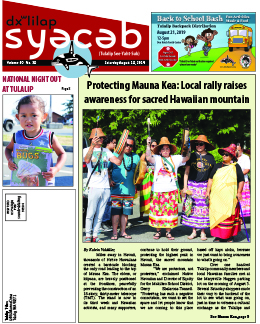
By Valerie Streeter, Tulalip Tribes Natural Resources Dept.
Bacteria levels at Mission Beach are very low this year! Harvey Eastman, Tulalip Water Quality Lab Manager, analyzes the weekly water samples collected by the Beach Watchers volunteers. The highest average so far was 7 mpn. Although previous years had levels lower than the 103 mpn limit threshold limit for swimming, there were spikes of higher bacterial levels at certain times.The first graph below shows the average results from the three beach sampling stations for this year. The red line shows the bacteria threshold limit (103 mpn/100mL) and the blue line is the average amount of bacteria in the water at Mission Beach for 2019. The second graph shows the results from the last three years. If bacterial levels are above the threshold limit, there are more chances for skin infections or stomach illness from too much pollution.


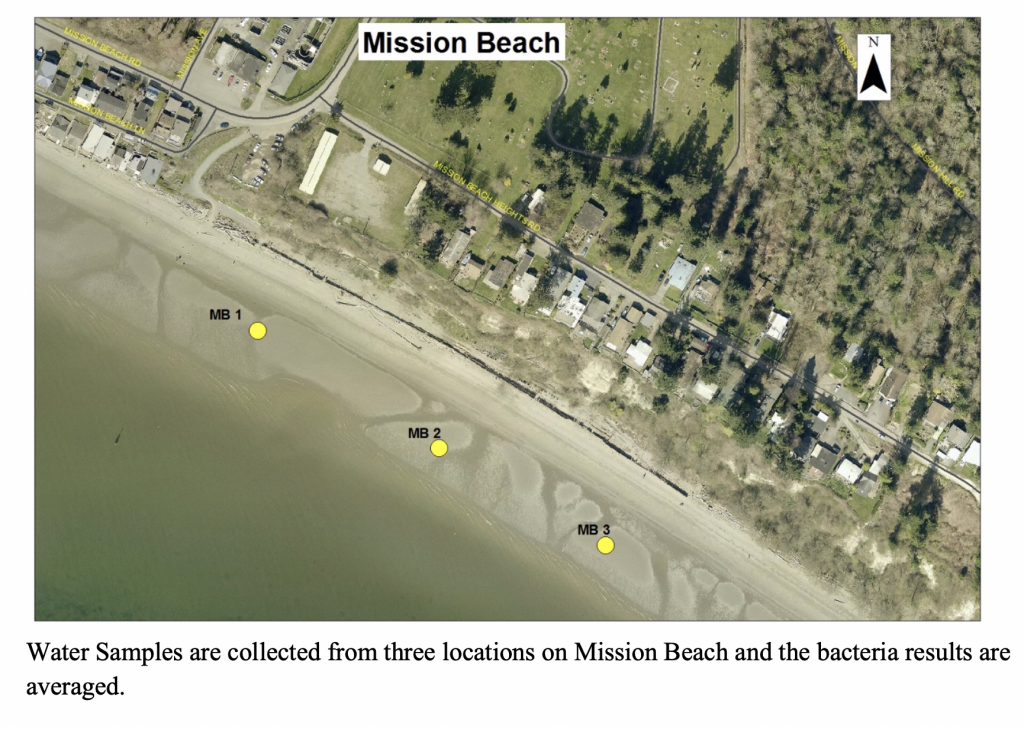

Please use the following link to download the August 3, 2019 issue of the syəcəb:

By Kalvin Valdillez, Tulalip News
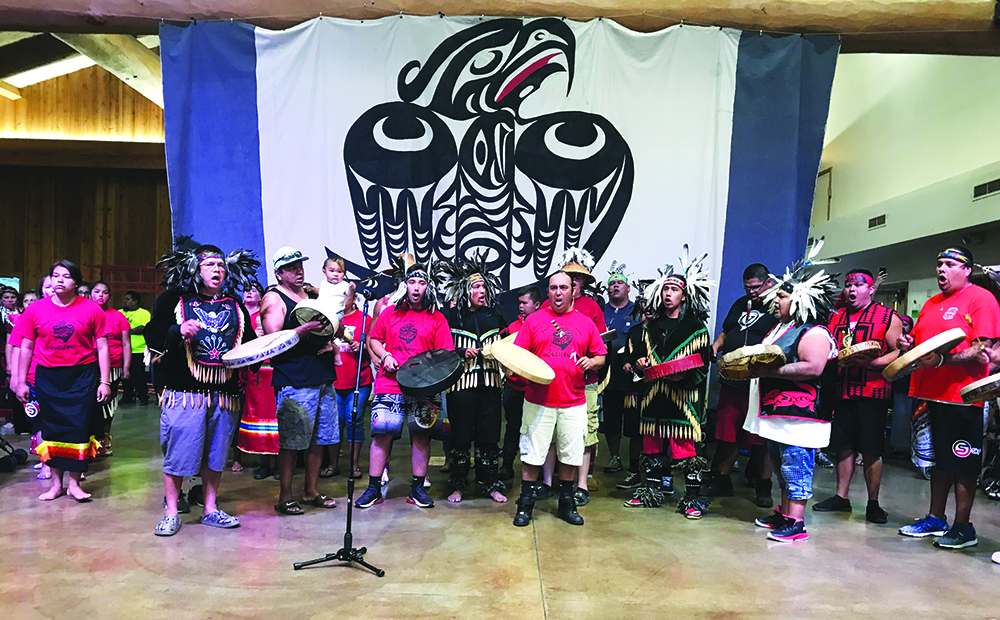
After spending several weeks on the water, resting at each tribal village along the way, over one hundred canoes landed at the Lummi Nation on the morning of July 24. The yearly summertime Canoe Journey is a popular occurrence in the Northwest as Coast Salish tribes and First Nation Bands travel the sacred waters in honor and celebration of Indigenous culture. Each year both tribal and non-tribal Washingtonians marvel at the beauty of the traditional cedar canoes as they navigate the Salish Sea. Thousands of photos are shared by news teams across social media as the canoes land at local tribes, but what’s not often shared are the events the take place for an entire week after the canoes reach their final destination during a series of potlatches known as protocol.
Lummi’s Wex’liem Building filled up quickly and was often at overcapacity during this year’s five-day protocol. Nearly seventy tribes shared their medicine throughout the week, offering their traditional songs and dances with the people.
Before Lummi’s opening ceremony, canoe families filled their bellies with salmon and frybread. A face painting station was set up behind a large thunderbird curtain where people could get the iconic handprint painted across their face, bringing awareness to the Missing and Murdered Indigenous Women (MMIW) epidemic. At approximately 8:00 p.m., Lummi singers gathered at the front of the community building and began drumming, officially kicking off the 2019 Paddle to Lummi protocol.
“It’s an honor to host you as our guests. Our family and relatives coming to visit and share some healing,” expressed Lummi Nation Vice Chairman, Travis Brockie. “We planned this in under a year and we came up with four themes. The first one being MMIW and the prayers that we have for the ones that we lost over the years, the ones who are still missing and the family’s that are searching for that healing. The second theme is the opioid crisis that we’re facing, fighting the pharmaceutical companies to keep these drugs off our reservations. The addiction that it’s brought is tearing our people apart. Third one is child welfare. For our children in the foster care system, our children that are being shipped across the state, every tribe is affected by that. We’re working on bringing our kids home, the system is failing our people. We have an uphill battle to fight. The last theme we thought of is salmon and our habitat. Without salmon, who are we as Indigenous people? That’s our bloodline and that’s who we are. Without salmon I don’t know where we’d be. It devastates us when our people can’t harvest to put food on their table, to pay their bills, it impacts us.”

A number of canoe families then joined Lummi by performing six songs during the shawl presentation, paying tribute to the many communities within Native America including the elders, youth, women, men, two-spirited and the MMIW. During each song, a shawl was displayed on the floor, representing and honoring each community while Protocol MC Terrance Adams shared the meaning behind each shawl.
“The button shawl signifies our elders,” he explained. “The ones who paved the way for us, who taught us, who continue to teach us. For all of our elders that left us something to carry on, to teach our little ones. The woven shawl honors our men. Each and every day I continue to pray that we have good strong men who will raise our young men and teach them the right way. It’s important that we have positive male role models in our community. The next one is a silk fringe shall for our women, the givers of life, the true protectors. The ones who continue to give us that love and nourishment we need.
“We have the two-spirited shawl. Growing up in this life, especially on the reservation, we need to embrace each and every person who comes into these sacred homes. We are taught to welcome with open arms. The two-spirited community has a huge voice in our community. It is very powerful for someone to come forward and claim their true identity and feel good about who they are. The cedar shawl represents our kids. Those who are abused, missing, assaulted. Those young ones who are survivors, not victims. Our kids will continue to survive. It’s important for us to pave the way for our future, you’re making your ancestors and our people proud. The last shawl is for the MMIW. There’s many rez’s where we have things set against us where we can’t prosecute, we can’t protect our own women on Indian land. We have families that are still searching for their loved ones. Our women dance for those women who can’t dance today, who can’t dance tomorrow. We continue to take their legacy on, share their story and teach our young ladies.”
Following the shawl presentation, the Lummi singers and dancers honored the many women who have gone missing throughout Indian Country by conducting a powerful and moving song which included the tear-jerking lyrics; “every day and every night I pray, pray for you/I love and miss you, sister come home”.
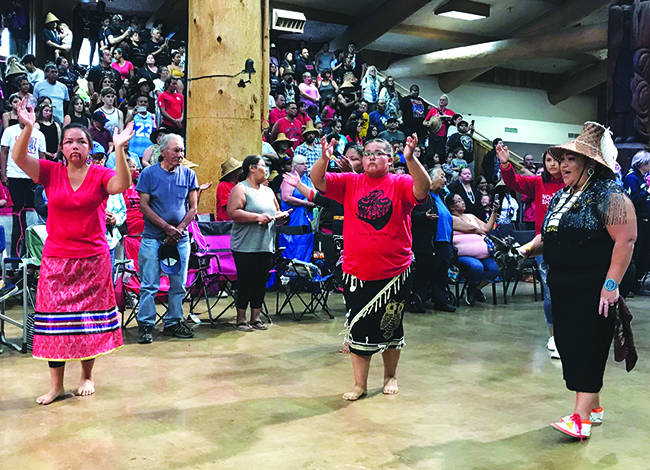
Once the crowd finished drying their eyes, Bella Bella was the first tribe up to offer songs, dances, stories and gifts to both the people and the hosting tribe. One after another, for five days straight, tribes and bands took to the floor showcasing their regalia, headdresses and traditions with their fellow Canoe Journey families. The Tulalip canoe family demonstrated a number of their songs on the fourth day of protocol. Taking an active role in this year’s journey, the Tulalip Youth Council were in attendance, proudly singing, drumming and dancing while representing their Tribe.
“We raise our hands and give thanks to Lummi and its leaders,” expressed Tulalip tribal member Natosha Gobin. “Thank you for inviting us to join in this amazing celebration. We are the Tulalip canoe family. This year we only had a couple short stops, but we traveled together on Big Brother and Big Sister. We have a lot of youth with us, a lot of first time canoe pullers. We’re very grateful and humble to arrive safely to your waters.”
With thousands witnessing protocol in person and hundreds more enjoying at home via livestream, the weeklong event brought together several generations in the name of love for the culture. The Paddle to Lummi was a great experience for youth and elders alike and a perfect opportunity for pullers to take part in the traditional lifeways of the Coast Salish people. Young Quinault tribal member and first time canoe puller, Kamimi Papp, shared her experience about being out on the water as well as participating in protocol.
“When I first started dancing during protocol, I felt as if I was praying to a higher power,” Kamimi stated. “I felt like I was one with the drums, a spirit being guided through a story. It was truly addicting and mesmerizing. My first Journey was indescribable. There are no words to explain the way you feel while paddling the ancestral highways. The closest words I can come up with are freeing and therapeutic. While on a canoe you feel a bond with the people on it, even if you don’t know them. You feel like you’re the heartbeat of the canoe, when your paddle touches the water you are the blood which pushes the canoe forward. It was amazing to meet new people who made an impression of a lifetime in that short amount of time. I will never forget the people I met through Journeys.”
The 2020 Canoe Journey will be hosted at Nanaimo, B.C. For more information, please visit the Tribal Canoe Journeys Facebook page.
By Kalvin Valdillez, Tulalip News
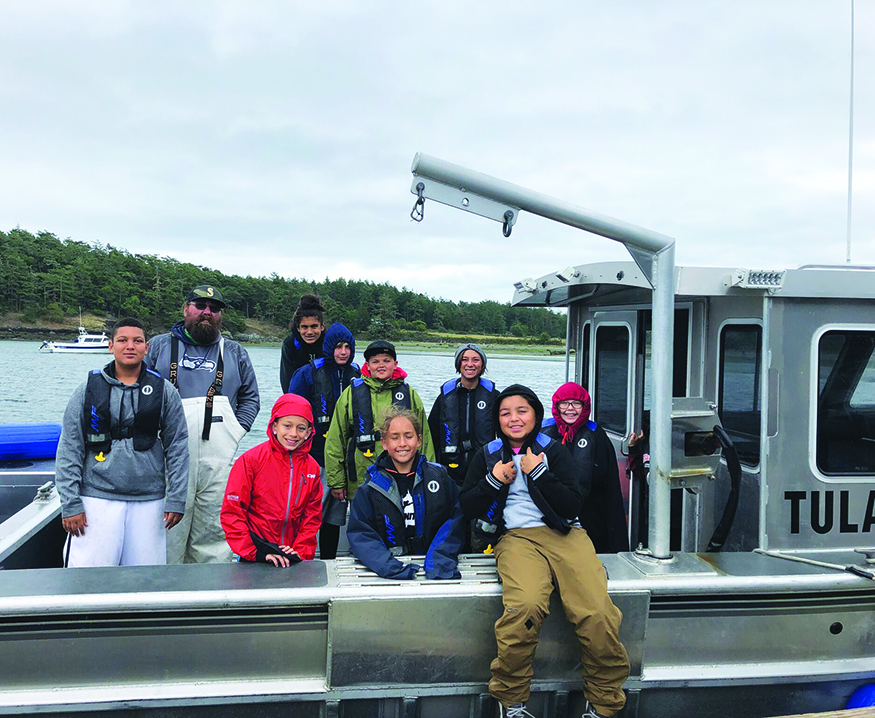
At the heart of the Salish Sea lies an island that shares a special connection to the Snohomish people. For centuries, Tulalip’s ancestors journeyed to the San Juan Islands every summer, setting up camp on what is known today as Lopez Island. Aside from exploring Lopez and it’s many surrounding islands, the Snohomish would fish and gather clams, crab, mussels, salmon and shrimp for their families in preparation for winter.
Fifteen local youth embarked on a camping excursion they may never forget during the week of July 15-20. Upon arriving to Lopez Island, by way of Washington State ferry, the youth experienced summer as their ancestors once had. By disconnecting from the modern world, the campers created new friendships with other young tribal members as well as a bond with the sacred waters. The kids set up camp at the south end of the island on a Tulalip owned private beach overlooking Watmough Bay. During their visit they learned about marine life, the history of their people and the many resources the island and waters have to offer.
“The kids don’t always have that opportunity to get out into nature,” explains Tulalip Natural Resources Outreach and Education Coordinator, Kelly Finley. “We want to provide a safe and fun way for them to get out there and see different parts of what is essentially tribal land. It’s important they take part in camps like these to experience the outdoors and the traditions of their people.”
Now in its second year, Fish Camp is open to local youth and is hosted by the Tribe’s Natural Resources department. The idea was originally inspired by Tulalip’s annual Mountain Camp, where young adults of the community spend a week at the Skykomish watershed learning about the natural world and how their people have hunted, gathered and performed spiritual work in the mountains since time immemorial. Fish Camp teaches the pre-teens another aspect of Northwest tribal lifeways, and both camps provide a perfect opportunity for the youth to not only learn about, but to also exercise their treaty rights.
“I think it’s important our youth experience Fish Camp on Lopez Island because that’s where our ancestors went,” expressed Michael Lotan, Tulalip tribal member and Fish Camp counselor. “They would dry clams out there and they would gather food for the upcoming winter season. We visited two sacred sites. One had really big middens, or shells and charcoal that proved our ancestors were once there. We also went to Watmough Bay and learned about all of the archeology sites that were there. We went to a couple beaches and looked for some agates and we jumped off the Tulalip dock, which was awesome. We were running and jumping as far as we could.”
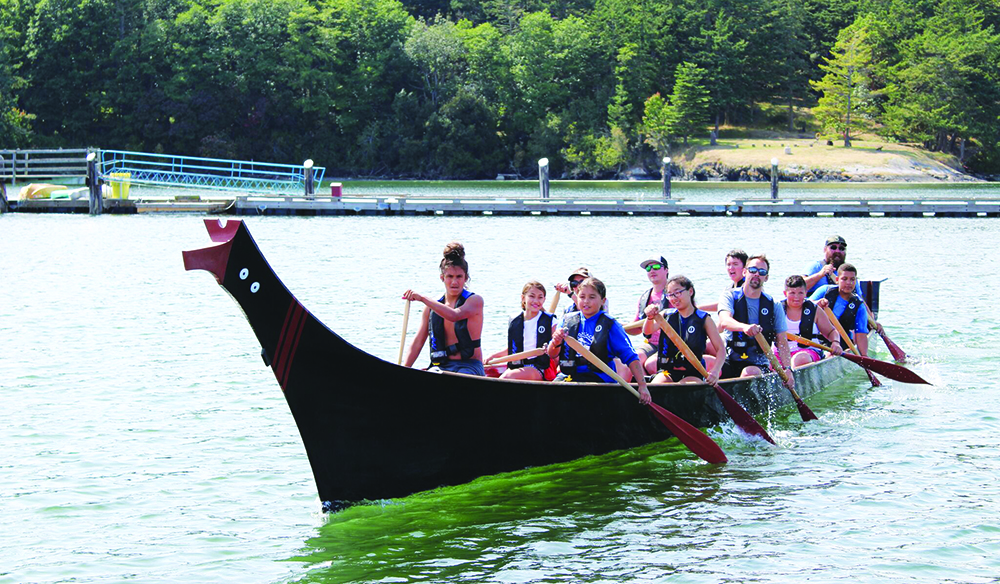
The kids were kept busy throughout the entire week, getting a first-hand look at Coast Salish traditions. A number of new activities were added this year including a chance to pull the Tribe’s traditional cedar dugout canoe, Big Brother. Skippered by Tulalip Fish and Wildlife Director Jason Gobin, the young adults paddled through the Salish waters, further strengthening the connection between the future generations and those ancestors who pulled in the same waterways many generations ago.
“It made my heart lift up seeing all you guys out there,” said Jason. “It reminded me of when we were all kids, running around all wild, it was a good time. This camp is great, the kids love it and it’s something we could always continue to build on.”
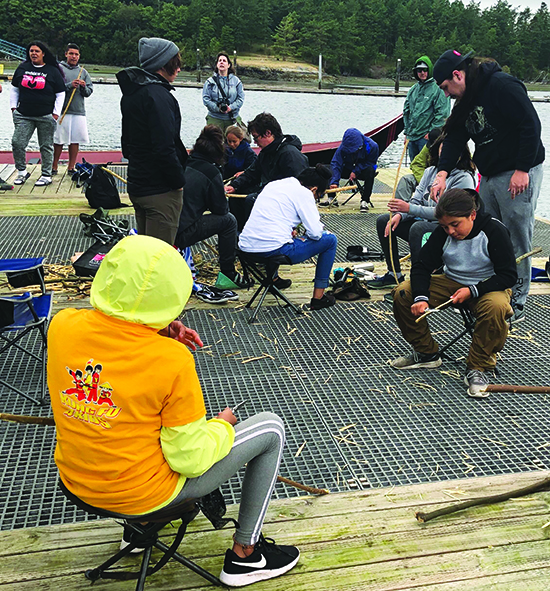
Another highlight of Fish Camp is the traditional clambake. Prepared by Tulalip tribal member Tony Hatch, the campers were treated to a delicious meal of salmon and shellfish, which they caught locally with seine nets and prepared near the campsite. Tribal member Cary Williams also made the journey to Lopez to teach the youth how to carve fish sticks, which were traditionally used to cook salmon fireside.
“We learned how to carve, we pulled canoe and we had a good time up there,” stated young Tribal member, Kane Hots. “We toured a few archeological sites. The rest of the time we were able to hang out with each other and go swimming. My favorite part was swimming because it’s summertime, and carving too. It was great to learn about our ancestors, about their teachings and how they were raised.”
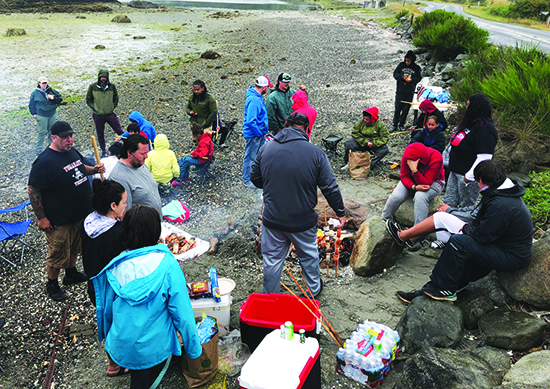
At the end of a culture and fun-filled week, the youth packed up camp and journeyed back to Tulalip where a celebration with their families took place. The kids enjoyed lunch after reuniting with their relatives and also received a number of gifts from Natural Resources including a certification of achievement, Fish Camp t-shirts and a blanket.
“It was a really good experience,” said Fish Camper and Navajo/Sioux tribal member, Mahina Curley. “The best part I think was the fact we were on a real cedar canoe. In my culture, we don’t have big bodies of water so that was really new to me. The fish on the stick seemed a little weird to me at first because we usually just fry it and eat it. I never had it on a stick before, but it was delicious. The clams and shrimp were really tasty and I liked learning about all the sacred places as well. It was a lot of fun, learning about another tribe was really cool. I definitely recommend it.”
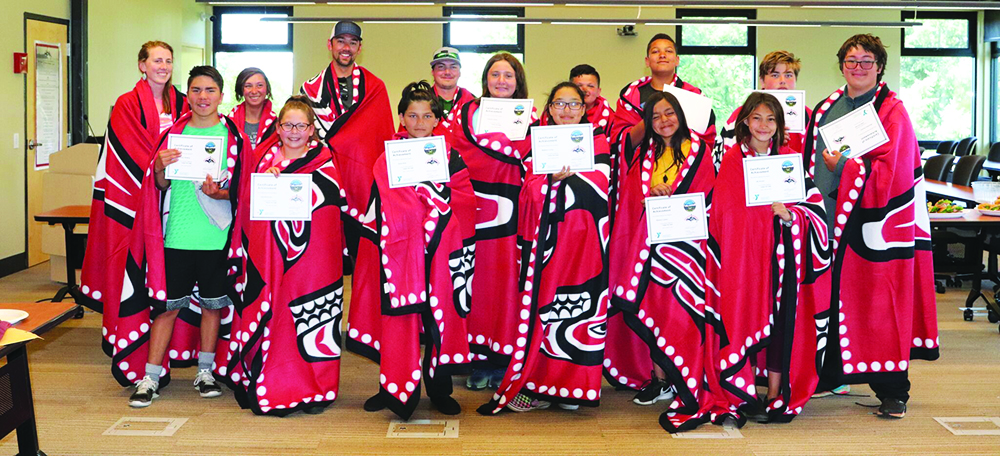
After another successful year at Fish Camp, Natural Resources is currently gearing up to host the 5th annual Youth Mountain Camp on August 5-10. For more information, please contact the Tulalip Tribes Natural Resources Department at (360) 716-4617.